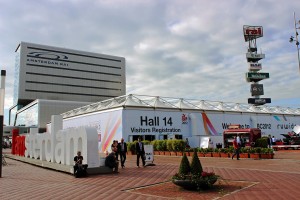
For the past two days, I have been immersed in the chaotic energy of the IBC Exhibition. Along with roughly 50,000 of my closest friends I have roamed the 14 halls of Amsterdam’s RAI convention center, taking in hundreds of booths from more than 1300 exhibitors, to see what’s new and exciting in the world of broadcast technology. After two busy days, I am now attempting to digest all the pamphlets and notes I have collected. Incidentally, I’ve also been digesting a couple of Heinekens, which leaves me wondering why beer tastes so much better in Europe. Maybe it’s the atmosphere. Or maybe European brewers conspire to ship their worst batches overseas. But I digress…
Now that I’ve stepped back from all the hustle and bustle of the convention to take a “mental squint” at the first two days, it is clear to me that the Broadcast industry is beginning to adapt to their rapidly evolving landscape. For a few years now, broadcasters have faced a complex transition to an unclear future. But at IBC 2012 I see evidence that they understand the disruptive forces in play, as well as the emerging opportunities. My best attempt to summarize the mindset of broadcasters at IBC 2012 is as follows:
Broadcasters are seeking new ways to manage and monetize their content, reaching new audiences on new platforms, while evolving their existing business models in a time of intense change.
Given this outlook, it should be no surprise that Connected TV is the most prominent theme at the IBC show this year. Connected TV presents a potential migratory path for the Broadcast industry, integrating internet paradigms with traditional broadcast business models. Connected TV envisions a future where consumers can enjoy high-quality interactive viewing experiences – watching any content, whenever they want to, on any internet-connected device. For broadcasters, Connected TV promises a technology platform that will enable them to expand their viewership, retain existing advertising and subscription revenues, while spawning incremental revenue streams from new services.
Connected TV could be the win/win scenario broadcasters have been looking for. The concept is compelling enough that the IBC created an entirely new Connected World Hall right in front of the RAI center (roughly 80,000 square feet!) as a showcase. But based on the conversations I’ve had with my counterparts walking the show floor, this transition is going to take time, as broadcasters continue to wrestle with the challenges of the here and now:
- Conversion from SD to HD. This transition is still in full swing in many geographies.
- Integration of IT infrastructure with traditional broadcast technology.
- Evolution from physical media assets to file-based workflow.
- Expansion of internet and mobile content delivery.
- Operational challenges stemming from increased complexity and budgetary pressures, including macroeconomic factors (especially in Southern Europe).
These challenges are not new – some of these evolutionary shifts are well into their second decade. But at IBC 2012, the Broadcast industry is starting to coalesce a compelling vision for the future. Yes, broadcasters are beginning to evolve! The key question remains, can they evolve quickly enough?
Thanks for reading this inaugural post for WireMosaic. As long as Amsterdam doesn’t suddenly run out of beer during the next 72 hours, I will continue to share my perspective on IBC, the state of the broadcast industry, and the latest news in media technology. Cheers!
